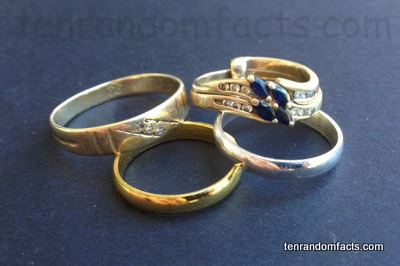A wedding ring is virtually part of many a person’s identity.
- A wedding ring is a jewellery item, generally given and worn as a symbol of a person’s marriage.
- Wedding rings are most frequently made of a metal such as platinum, gold or palladium, and are sometimes decorated with jewels or precious stones, and/or engraved with words or patterns.
- ‘Wedding rings’ are also known as ‘wedding bands’, and they are typically exchanged during a marriage ceremony.
- Wedding rings are thought to have originated in Ancient Egypt, made of reeds or other plant material, but later leather, ivory or bones became more common due to their durability, and in Roman times, iron became a popular choice.
- It is traditional for a wedding ring to be placed on the fourth, or ring finger, more commonly on the left hand, and some people rarely remove their ring, wearing it both night and day.
- In a number of countries, wedding rings were originally exclusively given to the female of a wedded pair, and this is still the case in some places; though, in the United States, by the end of the 1940s, rings given to both genders became the norm, particularly due to the ongoing public promotion by jewellers.
- Historically, the value of a wedding ring often symbolised the extent of love the giver had for the receiver, and commonly the cost of the ring was associated with the means of the giver.
- Wedding rings, or more specifically circles, were a symbol of eternity in Ancient Egypt, describing eternal love between the partners, however on its adaption into Roman culture, the ring’s meaning grew into a symbol of a man’s possession over a woman.
- According to popular legend, the fourth finger is believed to contain the mythical ‘love vein’ (Vena amoris), hence the wedding ring’s traditional position on the left hand; however, the position possibly originated from the Christian practice of a priest touching the first three fingers with the ring to symbolise the holy trinity, and then placing the ring on the fourth finger; or it may simply be that the ring was traditionally placed on one of the least used fingers on the least dominant hand to avoid wear of the material.
- Some cultures consider the wedding ring to be the final gift in a series of wedding gifts, and it may be the second ring given, the first being an ‘engagement ring’, however, for some people, it may be the only ring given.





